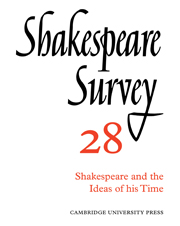Book contents
- Frontmatter
- ‘Richard II’ and the Realities of Power
- The Politics of Corruption in Shakespeare’s England
- Literature without Philosophy: ‘Antony and Cleopatra’
- Self-consciousness in Montaigne and Shakespeare
- ‘Measure for Measure’: The Bed-trick
- Shakespeare and the Doctrine of the Unity of Time
- ‘Coriolanus’ and the Body Politic
- ‘Titus Andronicus’, iii, i, 298–9
- ‘The Merchant of Venice’ and the Pattern of Romantic Comedy
- The Integrity of ‘Measure for Measure’
- ‘To Say One’: An Essay on ‘Hamlet’
- ‘The Tempest’ and King James’s ‘Daemonologie’
- Sight-lines in a Conjectural Reconstruction of an Elizabethan Playhouse
- The Smallest Season: The Royal Shakespeare Company at Stratford in 1974
- The Year's Contributions to Shakespearian Study 1 Critical Studies
- 2 Shakespeare’s Life, Times, and Stage
- 3 Textual Studies
- Index
- Plate section
‘The Merchant of Venice’ and the Pattern of Romantic Comedy
Published online by Cambridge University Press: 28 March 2007
- Frontmatter
- ‘Richard II’ and the Realities of Power
- The Politics of Corruption in Shakespeare’s England
- Literature without Philosophy: ‘Antony and Cleopatra’
- Self-consciousness in Montaigne and Shakespeare
- ‘Measure for Measure’: The Bed-trick
- Shakespeare and the Doctrine of the Unity of Time
- ‘Coriolanus’ and the Body Politic
- ‘Titus Andronicus’, iii, i, 298–9
- ‘The Merchant of Venice’ and the Pattern of Romantic Comedy
- The Integrity of ‘Measure for Measure’
- ‘To Say One’: An Essay on ‘Hamlet’
- ‘The Tempest’ and King James’s ‘Daemonologie’
- Sight-lines in a Conjectural Reconstruction of an Elizabethan Playhouse
- The Smallest Season: The Royal Shakespeare Company at Stratford in 1974
- The Year's Contributions to Shakespearian Study 1 Critical Studies
- 2 Shakespeare’s Life, Times, and Stage
- 3 Textual Studies
- Index
- Plate section
Summary
Nicholas Rowe doubted the propriety of considering The Merchant of Venice a comedy, going so far as to conjecture that it was ‘design’d Tragically’ by Shakespeare, while two and a half centuries later W. H. Auden asserted that it should be classed among his ‘Unpleasant Plays’. Interpretations of the play, whether arguing for its romantic idealism or its disturbing realism, or for a compromise between these extremes, has necessarily grappled with the problem of the moral status of both Shylock and the Christians. Yet, despite the views of Rowe and Auden, and other stances of unease in response to that issue, The Merchant of Venice retains its place among the romantic comedies. The present undertaking is not to affirm or deny that placing, and certainly not to fish again in the troubled waters of the ‘Shylock problem’, for that occupation can divert attention from other equally significant features that make the play eccentric among the romantic comedies. The friendship of Antonio for Bassanio has attracted attention but the uniqueness of that portrayal has not been sufficiently stressed, or at least been given the right kind of stress. It is importantly related to another unique feature of the play which, given its major significance, can be said to have been neglected. If Love’s Labour’s Lost has a special place among the romantic comedies in that ‘Jack hath not Jill’ at the end of the play so also has The Merchant of Venice in that its marriages occur halfway through.
- Type
- Chapter
- Information
- Shakespeare Survey , pp. 75 - 88Publisher: Cambridge University PressPrint publication year: 1975
- 2
- Cited by

